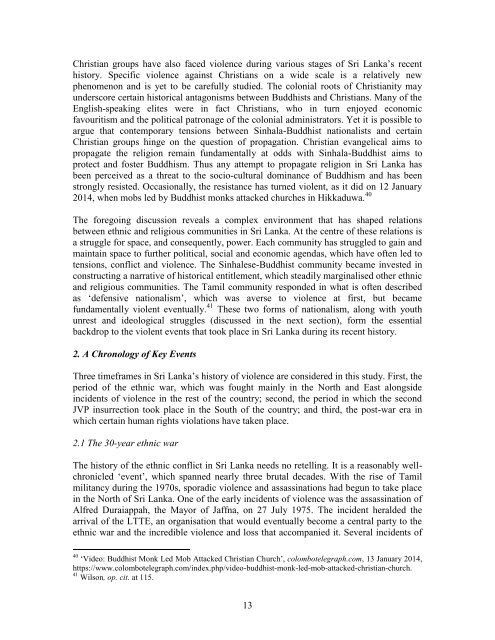Confronting the Complexity of Loss
truth memory justice_final- 11st sep 2015
truth memory justice_final- 11st sep 2015
- No tags were found...
Create successful ePaper yourself
Turn your PDF publications into a flip-book with our unique Google optimized e-Paper software.
Christian groups have also faced violence during various stages <strong>of</strong> Sri Lanka’s recent<br />
history. Specific violence against Christians on a wide scale is a relatively new<br />
phenomenon and is yet to be carefully studied. The colonial roots <strong>of</strong> Christianity may<br />
underscore certain historical antagonisms between Buddhists and Christians. Many <strong>of</strong> <strong>the</strong><br />
English-speaking elites were in fact Christians, who in turn enjoyed economic<br />
favouritism and <strong>the</strong> political patronage <strong>of</strong> <strong>the</strong> colonial administrators. Yet it is possible to<br />
argue that contemporary tensions between Sinhala-Buddhist nationalists and certain<br />
Christian groups hinge on <strong>the</strong> question <strong>of</strong> propagation. Christian evangelical aims to<br />
propagate <strong>the</strong> religion remain fundamentally at odds with Sinhala-Buddhist aims to<br />
protect and foster Buddhism. Thus any attempt to propagate religion in Sri Lanka has<br />
been perceived as a threat to <strong>the</strong> socio-cultural dominance <strong>of</strong> Buddhism and has been<br />
strongly resisted. Occasionally, <strong>the</strong> resistance has turned violent, as it did on 12 January<br />
2014, when mobs led by Buddhist monks attacked churches in Hikkaduwa. 40<br />
The foregoing discussion reveals a complex environment that has shaped relations<br />
between ethnic and religious communities in Sri Lanka. At <strong>the</strong> centre <strong>of</strong> <strong>the</strong>se relations is<br />
a struggle for space, and consequently, power. Each community has struggled to gain and<br />
maintain space to fur<strong>the</strong>r political, social and economic agendas, which have <strong>of</strong>ten led to<br />
tensions, conflict and violence. The Sinhalese-Buddhist community became invested in<br />
constructing a narrative <strong>of</strong> historical entitlement, which steadily marginalised o<strong>the</strong>r ethnic<br />
and religious communities. The Tamil community responded in what is <strong>of</strong>ten described<br />
as ‘defensive nationalism’, which was averse to violence at first, but became<br />
fundamentally violent eventually. 41 These two forms <strong>of</strong> nationalism, along with youth<br />
unrest and ideological struggles (discussed in <strong>the</strong> next section), form <strong>the</strong> essential<br />
backdrop to <strong>the</strong> violent events that took place in Sri Lanka during its recent history.<br />
2. A Chronology <strong>of</strong> Key Events<br />
Three timeframes in Sri Lanka’s history <strong>of</strong> violence are considered in this study. First, <strong>the</strong><br />
period <strong>of</strong> <strong>the</strong> ethnic war, which was fought mainly in <strong>the</strong> North and East alongside<br />
incidents <strong>of</strong> violence in <strong>the</strong> rest <strong>of</strong> <strong>the</strong> country; second, <strong>the</strong> period in which <strong>the</strong> second<br />
JVP insurrection took place in <strong>the</strong> South <strong>of</strong> <strong>the</strong> country; and third, <strong>the</strong> post-war era in<br />
which certain human rights violations have taken place.<br />
2.1 The 30-year ethnic war<br />
The history <strong>of</strong> <strong>the</strong> ethnic conflict in Sri Lanka needs no retelling. It is a reasonably wellchronicled<br />
‘event’, which spanned nearly three brutal decades. With <strong>the</strong> rise <strong>of</strong> Tamil<br />
militancy during <strong>the</strong> 1970s, sporadic violence and assassinations had begun to take place<br />
in <strong>the</strong> North <strong>of</strong> Sri Lanka. One <strong>of</strong> <strong>the</strong> early incidents <strong>of</strong> violence was <strong>the</strong> assassination <strong>of</strong><br />
Alfred Duraiappah, <strong>the</strong> Mayor <strong>of</strong> Jaffna, on 27 July 1975. The incident heralded <strong>the</strong><br />
arrival <strong>of</strong> <strong>the</strong> LTTE, an organisation that would eventually become a central party to <strong>the</strong><br />
ethnic war and <strong>the</strong> incredible violence and loss that accompanied it. Several incidents <strong>of</strong><br />
40 ‘Video: Buddhist Monk Led Mob Attacked Christian Church’, colombotelegraph.com, 13 January 2014,<br />
https://www.colombotelegraph.com/index.php/video-buddhist-monk-led-mob-attacked-christian-church.<br />
41 Wilson, op. cit. at 115.<br />
13



